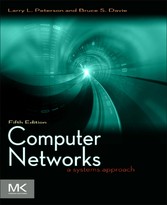Suchen und Finden
Front Cover
1
Computer Networks
6
Copyright
7
Dedication
8
Foreword
10
Foreword to the First Edition
12
Preface
14
Table of Contents
26
Chapter 1. Foundation
34
Problem: Building a Network
34
1.1 Applications
35
1.2 Requirements
39
1.3 Network Architecture
57
1.4 Implementing Network Software
69
1.5 Performance
77
1.6 Summary
88
What’s Next: Cloud Computing
90
Further Reading
91
Exercises
93
Chapter 2. Getting Connected
104
Problem: Connecting to a Network
104
2.1 Perspectives on Connecting
105
2.2 Encoding (NRZ, NRZI, Manchester, 4B/5B)
111
2.3 Framing
114
2.4 Error Detection
124
2.5 Reliable Transmission
135
2.6 Ethernet and Multiple Access Networks (802.3)
152
2.7 Wireless
161
2.8 Summary
181
What’s Next: “The Internet of Things”
183
Further Reading
184
Exercises
186
Chapter 3. Internetworking
202
Problem: Not All Networks are Directly Connected
202
3.1 Switching and Bridging
203
3.2 Basic Internetworking (IP)
236
3.3 Routing
273
3.4 Implementation and Performance
299
3.5 Summary
313
What’s Next: The Future Internet
314
Further Reading
315
Exercises
317
Chapter 4. Advanced Internetworking
340
Problem: Scaling to Billions
340
4.1 The Global Internet
341
4.2 Multicast
371
4.3 Multiprotocol Label Switching (MPLS)
387
4.4 Routing among Mobile Devices
402
4.5 Summary
412
What’s Next: Deployment of IPv6
413
Further Reading
414
Exercises
415
Chapter 5. End-to-End Protocols
424
Problem: Getting Process to Communicate
424
5.1 Simple Demultiplexer (UDP)
426
5.2 Reliable Byte Stream (TCP)
429
5.3 Remote Procedure Call
464
5.4 Transport for Real-Time Applications (RTP)
480
5.5 Summary
493
What’s Next: Transport Protocol Diversity
494
Further Reading
495
Exercises
496
Chapter 6. Congestion Control and Resource Allocation
512
Problem: Allocating Resources
512
6.1 Issues in Resource Allocation
513
6.2 Queuing Disciplines
525
6.3 TCP Congestion Control
532
6.4 Congestion-Avoidance Mechanisms
547
6.5 Quality of Service
563
6.6 Summary
592
What’s Next: Refactoring the Network
593
Further Reading
594
Exercises
596
Chapter 7. End-to-End Data
612
Problem: What Do We Do with the Data?
612
7.1 Presentation Formatting
614
7.2 Multimedia Data
629
7.3 Summary
654
What’s Next: Video Everywhere
655
Further Reading
656
Exercises
657
Chapter 8. Network Security
666
Problem: Security Attacks
666
8.1 Cryptographic Building Blocks
668
8.2 Key Predistribution
680
8.3 Authentication Protocols
687
8.4 Example Systems
697
8.5 Firewalls
714
8.6 Summary
719
What’s Next: Coming to Grips with Security
721
Further Reading
722
Exercises
723
Chapter 9. Applications
730
Problem: Applications Need their Own Protocols
730
9.1 Traditional Applications
731
9.2 Multimedia Applications
760
9.3 Infrastructure Services
777
9.4 Overlay Networks
792
9.5 Summary
822
What’s Next: New Network Architecture
823
Further Reading
824
Exercises
826
Solutions to Select Exercises
834
Glossary
848
Bibliography
870
Index
884
Alle Preise verstehen sich inklusive der gesetzlichen MwSt.








